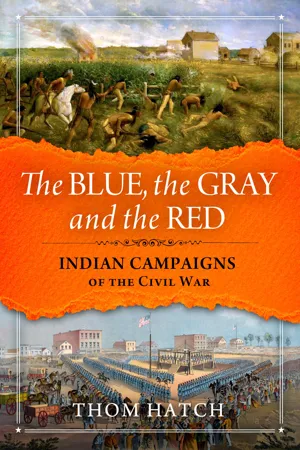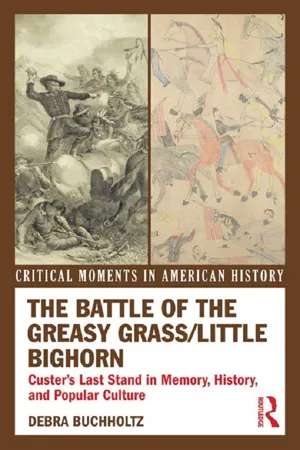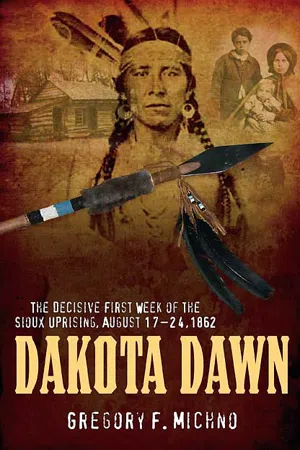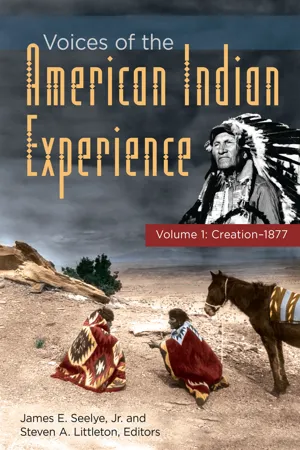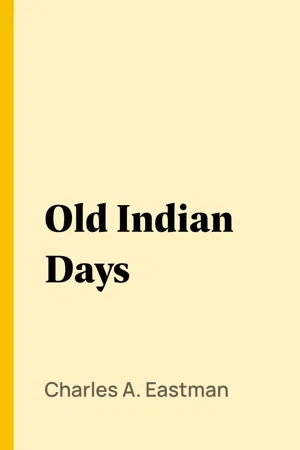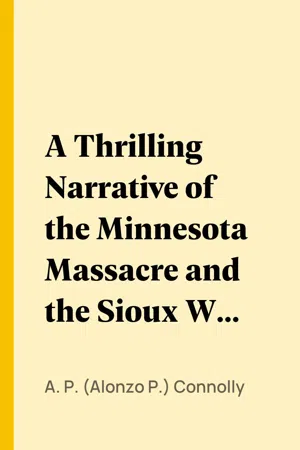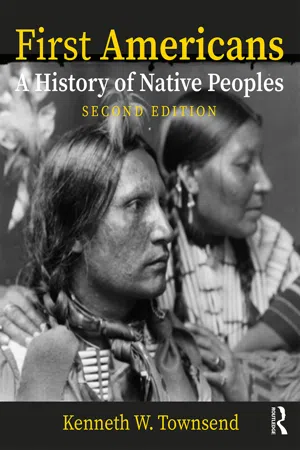History
Little Crow's War
Little Crow's War, also known as the Dakota War of 1862, was a conflict between the Dakota Sioux and the United States. It was sparked by broken treaties, starvation, and mistreatment of the Dakota people. The war resulted in the largest mass execution in U.S. history, with 38 Dakota men hanged in Mankato, Minnesota.
Written by Perlego with AI-assistance
Related key terms
Related key terms
1 of 4
Related key terms
1 of 3
9 Key excerpts on "Little Crow's War"
- eBook - ePub
- Thom Hatch(Author)
- 2020(Publication Date)
- Turner(Publisher)
Other grievances against the whites were aired and, although many considered it a folly to engage in war against such a strong adversary, it was finally decided that they could not simply wait for retaliation. The Dakota must seize the offensive. Little Crow, whom the others believed had the prestige and ability to lead a fight against the white man, was at first reluctant to participate—until he was called a coward by one of the more hot-blooded warriors. That insult aroused Little Crow, who threw that warrior’s headdress to the ground and delivered an impassioned speech in which he announced that he would lead an attack on the white man in the morning. This decision certainly contradicted the chief’s past behavior, and even now he held to the opinion that his people were doomed in any fight with the whites. Little Crow, however, had chosen to follow what he believed were his obligations to his tribe as a warrior. Dakota Sioux warriors, led by Chief Little Crow, went on a rampage that warm summer morning of August 18 that left a trail of bloodletting perhaps unparalleled in recorded history. Robert Utley in his Frontiersmen in Blue perhaps summed up the carnage best when he wrote: “The warriors swept through Redwood Agency, killed the men, took the women and children captive, and put the buildings to the torch. In wide-ranging parties, they spread over the countryside, killing, raping, pillaging, and burning - eBook - ePub
- Charles A. Eastman(Author)
- 2008(Publication Date)
- Perlego(Publisher)
Meanwhile, to make matters worse, the cash annuities were not paid for nearly two years. Civil War had begun. When it was learned that the traders had taken all of the ninety-eight thousand dollars “on account”, there was very bitter feeling. In fact, the heads of the leading stores were afraid to go about as usual, and most of them stayed in St. Paul. Little Crow was justly held in part responsible for the deceit, and his life was not safe.The murder of a white family near Acton, Minnesota, by a party of Indian duck hunters in August, 1862, precipitated the break. Messengers were sent to every village with the news, and at the villages of Little Crow and Little Six the war council was red-hot. It was proposed to take advantage of the fact that north and south were at war to wipe out the white settlers and to regain their freedom. A few men stood out against such a desperate step, but the conflagration had gone beyond their control.There were many mixed bloods among these Sioux, and some of the Indians held that these were accomplices of the white people in robbing them of their possessions, therefore their lives should not be spared. My father, Many Lightnings, who was practically the leader of the Mankato band (for Mankato, the chief, was a weak man), fought desperately for the lives of the half-breeds and the missionaries. The chiefs had great confidence in my father, yet they would not commit themselves, since their braves were clamoring for blood. Little Crow had been accused of all the misfortunes of his tribe, and he now hoped by leading them against the whites to regain his prestige with his people, and a part at least of their lost domain.There were moments when the pacifists were in grave peril. It was almost daybreak when my father saw that the approaching calamity could not be prevented. He and two others said to Little Crow: “If you want war, you must personally lead your men to-morrow. We will not murder women and children, but we will fight the soldiers when they come.” They then left the council and hastened to warn my brother-in-law, Faribault, and others who were in danger.Little Crow declared he would be seen in the front of every battle, and it is true that he was foremost in all the succeeding bloodshed, urging his warriors to spare none. He ordered his war leader, Many Hail, to fire the first shot, killing the trader James Lynd, in the door of his store. - eBook - ePub
The Battle of the Greasy Grass/Little Bighorn
Custer's Last Stand in Memory, History, and Popular Culture
- Debra Buchholtz(Author)
- 2013(Publication Date)
- Routledge(Publisher)
Newspaper reporters and popular writers of the late 1870s certainly played a major role in securing the battle’s place in history but one must not overestimate their contribution. Distracted by the actions and personalities of Custer—whom they construed as an endearing, almost recklessly courageous, and youthful icon of blossoming civilization—and Sitting Bull—whom they construed as Custer’s polar opposite and a stereotypically stoic and menacing symbol of the untamed wilderness and “savage” past—they generally promoted a Great Man reading of the Greasy Grass/Little Bighorn battle and the events that preceded it. But what happened cannot be reduced to an outcome of decisions and actions taken by a few “great” men and women nor can its continuing resonance be explained by this simple polarization. Context was and still is everything: the battle itself and the challenges it posed to American sensibilities were very much a product of their time, as were the decisions made by Sitting Bull and Custer. The symbolic contrast between these two colorful and powerful antagonists and the detailed focus on their actions and motivations have always fired the imaginations of ordinary people by adding drama and dimension to the historic moment. Nonetheless, social, cultural, political, and economic factors that originated in the particular context in which the battle occurred and the many contexts in which it has since been recounted, coupled with its multivocality, have been more crucial to securing its enduring salience than any clash of personalities.Many other factors have undoubtedly contributed to the battle’s status as a critical, if discursively unstable, moment in the American past but two are particularly noteworthy. The first is the overarching but generally unspoken objective of the military campaign against the off-reservation Lakota and Cheyenne. The second is the painful irony of the battle’s centennial year timing.Although ostensibly a major victory for the Lakota and Cheyenne and a catastrophic defeat for the cavalry, Custer’s Last Stand or the Little Bighorn battle was less a military engagement than a calculated maneuver in the American nation-building project, albeit one that appeared at first to have gone badly wrong. Access to land and natural resources and the safety of the settlers and other security issues ranked high among the army’s officially stated objectives in its campaign against the Lakota and Cheyenne roaming off the reservation. Nonetheless, it was a less tangible objective that arguably did most initially to install the battle as a critical moment in the American past. The nature of that objective is intimated by the alternate names for the army’s campaign popularized by writers in later years: the Sioux War and the Centennial Campaign. Together these two designators invoke the hopes and fears of the American people in the centennial year: optimism for a future at the vanguard of progress tinged with unease over the militant independence of the non-treaty Indians still wreaking havoc out on the northern Plains. The unspoken but widely recognized objective of the 1876 campaign was to enhance and consolidate the integrity of the nation by subduing the unruled and unruly northern Plains tribes and sequestering them on reservations until they either died off or were ready for incorporation into the American body politic. It was an assimilationist objective that dovetailed neatly with post-Civil War efforts to cobble unity out of diversity within the newly reunited nation’s borders, which now stretched from coast to coast. It also conveniently promised to open badly needed lands to white settlers and economic exploitation. - eBook - ePub
Dakota Dawn
The Decisive First Week of the Sioux Uprising, August 1862
- Gregory Michno(Author)
- 2011(Publication Date)
- Savas Beatie(Publisher)
Seeing the destructive results of drunkenness, Little Crow encouraged temperance and invited Presbyterian Dr. Thomas Williamson to establish a mission at his village—yet he would not call himself a Christian. He supported farming efforts and wore white man’s clothing—but he still preserved his Indian identity by not personally tilling the soil. Little Crow became a power broker who sought to get the best deal for his people while trying “to satisfy an insatiable personal hunger for power.” He “was a politician who happened to be an Indian….” 5 The chief showed what he was made of during the negotiations at Mendota. Wabasha again broached the subject of unpaid money from the 1837 treaty when the Dakotas sold their lands east of the Mississippi. Lea and Ramsey promised that the money would be included in the new treaty, but the Indians were not convinced. As the talks progressed, Little Crow supported the Indians’ interests, but was willing to compromise. Another point of contention was the boundary of the new reservation. The government wanted the southeastern boundary to be where the Redwood River enters the Minnesota River; the Mdewakantons and Wahpekutes wanted it as far east as Traverse des Sioux—these Dakotas were essentially woodland Indians and did not want to live out on the open prairies as did the Nakotas and Lakotas. Little Crow gained the support of a few other chiefs, and it appeared that they would sign, if only the boundary could be settled. Lea and Ramsey suggested a compromise line about halfway between the two points, at the mouth of the Little Rock River. The Indians appeared willing, but Wabasha turned to the crowd and asked if anyone intended to kill the first chief who signed. Red Middle Voice said it would not happen and indicated his willingness for a treaty. Ramsay took the quill and asked Medicine Bottle who should be the first - eBook - ePub
- Hanford Lennox Gordon(Author)
- 2005(Publication Date)
- Perlego(Publisher)
From him personally I obtained much information in regard to Little Crow's participation in the "Sioux War," and minutely the speech that Little Crow made to his braves when he finally consented to lead them on the war-path against the whites. A literal translation of that speech will be found further on in this note. I knew Ta-ó-ya-te-dú-ta, and from his own lips, in 1859-60 and 61, obtained much interesting information in regard to the history, tradition, customs, superstitions and habits of the Dakotas, of whom he was the recognized Head-Chief. He was a remarkable Indian—a philosopher and a brave and generous man. "Untutored savage" that he was, he was a prince among his own people, and the peer in natural ability of the ablest white men in the Northwest in his time. He had largely adopted the dress and habits of civilized man, and he urged his people to abandon their savage ways, build houses, cultivate fields, and learn to live like the white people. He clearly forsaw the ultimate extinction of his people as a distinct race. He well knew and realized the numbers and power of the whites then rapidly taking possession of the hunting-grounds of the Dakotas, and the folly of armed opposition on the part of his people. He said to me once: "No more Dakotas by and by; Indians all white men. No more buffaloes by and by; all cows, all oxen." But his braves were restless. They smarted under years of wrong and robbery, to which, indeed, the most stinging insults were often added by the traders and officials among them - eBook - ePub
Voices of the American Indian Experience
[2 volumes]
- James E. Seelye Jr., Steven Alden Littleton, James E. Seelye Jr., Steven Alden Littleton, James E. Seelye Jr., Steven Alden Littleton(Authors)
- 2012(Publication Date)
- Greenwood(Publisher)
When one of these people conceives himself injured his thirst for revenge is insatiable. Grave and dignified in his outward bearing, and priding himself upon never exhibiting curiosity, joy, or anger, yet when once roused he evinces the implacable dispositions of his race; the affront is laid up and cherished in his breast, and nothing can efface it from his mind until ample reparation is made. The insult must be atoned for by presents, or be washed out with blood.Source: Randolph B. Marcy. The Prairie Traveler: A Hand-Book for Overland Expeditions , 200–202, 205–19. New York: Harper & Brothers, 1859.Passage contains an image
83
Big Eagle’s Account of the Dakota War of 1862
In June 1894, Jerome Big Eagle, a warrior and band leader of the Dakota Indians in Minnesota provided the following account for the causes of the Dakota War of 1862. Big Eagle’s account provides a counter-explanation to the white narrative of this conflict, in which 400 to 800 white settlers and as many as 100 Native Americans lost their lives. Big Eagle argues that unhappiness about treaty agreements, mistreatment of Native Americans, and a belief that Minnesota residents were vulnerable to attack are some of the causes that ultimately led to the conflict.Interestingly, while Big Eagle argues for a more complex understanding of the causes of the war, he also employs the trope of the vanishing, or doomed, Indian in this narrative, stating that he knew the United States would eventually overpower and defeat his people. This is exactly the kind of message many 19th-century Americans wanted to hear. The period from 1890 to 1920 represents the nadir of American race relations and is characterized by the restriction of civil rights, violence, and other forms of discrimination. Americans feared the effect that immigrants and minorities would have on white social and cultural institutions if left unchecked. Big Eagle’s narrative, therefore, served a dual purpose when originally published. It broadened the nation’s understanding of the Dakota uprising while simultaneously reassuring fin de siècle United States of past victories in which white communities resisted attacks from different racial groups.I was born in the Indian village of my father near Mendota, in 1827, and am now sixty-seven years old. My father was Grey Iron, a sub-chief of the Midawa-xanton Sioux. When he died I succeeded him as chief of the band and adopted the name of his father, Wambdetonka, which, as is commonly called, means the Big Eagle. When I was a young man I often went with war parties against the Chippewa and other enemies of my nation, and the six feathers shown in the headdress of my picture in the historical society at St. Paul stand for six Chippewa scalps that I took when on the warpath. By the terms of the treaties of Traverse des Sioux and Mendota in 1851, the Sioux sold all of their lands in Minnesota, except a strip ten miles wide on each side of the Minnesota river from near Fort Ridgely to the Big Stone lake. The Medawakantons and Wacoutas had their reservation up to the Yellow Medicine. In 1858 the ten miles of this strip belonging to the Medawakanton and Wacouta bands, and lying north of the river were sold, mainly through the influence of Little Crow. That year, with some other chiefs, I went to Washington on business connected with the treaty. The selling of that strip north of the Minnesota caused great dissatisfaction among the Sioux, and Little Crow was always blamed for the part he took in the sale. It caused us all to move to the south side of the river, where there was but very little game, and many of our people, under the treaty, were induced to give up the old life and go to work like white men, which was very distasteful to many. - eBook - ePub
- Charles A. Eastman(Author)
- 2008(Publication Date)
- Perlego(Publisher)
The white traders and Government employees, those of them who were up and about, heard and saw the advancing column of warriors. Yet they showed no sign of anxiety or fear. Most of them thought that there might be some report of Ojibways coming to attack the Sioux,—a not uncommon incident,—and that those warriors were on their way to the post to replenish their powder-horns. A few of the younger men were delighted with the prospect of witnessing an Indian fight.On swept the armed band, in numbers increasing at every village.It was true that there had been a growing feeling of distrust among the Indians, because their annuities had been withheld for a long time, and the money payments had been delayed again and again. There were many in great need. The traders had given them credit to some extent (charging them four times the value of the article purchased), and had likewise induced Little Crow to sign over to them ninety-eight thousand dollars, the purchase-price of that part of their reservation lying north of the Minnesota, and already occupied by the whites.This act had made the chief very unpopular, and he was ready for a desperate venture to regain his influence. Certain warriors among the upper bands of Sioux had even threatened his life, but no one spoke openly of a break with the whites.When, therefore, the news came to Little Crow that some roving hunters of the Rice Creek band had killed in a brawl two families of white settlers, he saw his opportunity to show once for all to the disaffected that he had no love for the white man. Immediately he sprang upon his white horse, and prepared to make their cause a general one among his people.Tawasuota had scarcely finished his hasty preparations for war, by painting his face and seeing to the loading of his gun, when he heard the voice of Little Crow outside his lodge.“You are now my head soldier,” said the chief, “and this is your first duty. Little Six and his band have inaugurated the war against the whites. They have already wiped out two families, and are now on their way to the agency. Let my chief soldier fire the first shot. - eBook - ePub
A Thrilling Narrative of the Minnesota Massacre and the Sioux War of 1862-63
Graphic Accounts of the Siege of Fort Ridgely, Battles of Birch Coolie, Wood Lake, Big Mound, Stony Lake, Dead Buffalo Lake and Missouri River
- A. P. (Alonzo P.) Connolly(Author)
- 2016(Publication Date)
- Perlego(Publisher)
The year of which I write was a time in St. Paul when the Indian was almost one’s next door neighbor,—a time when trading between St. Paul and Winnipeg was carried on principally by half-breeds, and the mode of transportation the crude Red river cart, which is made entirely of wood,—not a scrap of iron in its whole make-up. The team they used was one ox to a cart, and the creak of this long half-breed train, as it wended its way over the trackless country, could be heard twice a year as it came down to the settlements laden with furs to exchange for supplies for families, and hunting purposes. It was at a time when the hostile bands of Sioux met bands of Chippewas, and in the immediate vicinity engaged in deadly conflict, while little attention was paid to their feuds by the whites or the government at Washington.CHAPTER VIII. LITTLE CROW AT DEVIL’S LAKE. It was in August, 1861, on the western border of Devil’s Lake, Dakota, there sat an old Indian chief in the shade of his wigwam, preparing a fresh supply of kinnikinnick.The mantle of evening was veiling the sky as this old chief worked and the events of the past were crowding his memory. He muses alone at the close of the day, while the wild bird skims away on its homeward course and the gathering gloom of eventide causes a sigh to escape his breast, as many sweet pictures of past happy years “come flitting again with their hopes and their fears.” The embers of the fire have gone out and he and his dog alone are resting on the banks of the lake after the day’s hunt; and, as he muses, he wanders back to the time when in legend lore the Indian owned the Western world; the hills and the valleys, the vast plains and their abundance, the rivers, the lakes and the mountains were his; great herds of buffalo wended their way undisturbed by the white hunter; on every hand abundance met his gaze, and the proud Red Man with untainted blood, and an eye filled with fire, looked out toward the four points of the compass, and, with beating heart, thanked the Great Spirit for this goodly heritage. To disturb his dream the white man came, and as the years rolled on, step by step, pressed him back;—civilization brought its cunning and greed for money-getting. A generous government, perhaps too confiding, allowed unprincipled men to rob and crowd, and crowd and rob, until the Mississippi is reached and the farther West is portioned out to him for his future residence. The influx of whites from Europe and the rapidly increasing population demand more room, and another move is planned by the government for the Indians, until they are crowding upon the borders of unfriendly tribes. - eBook - ePub
First Americans: A History of Native Peoples, Combined Volume
A History of Native Peoples, PowerPoints
- Kenneth W. Townsend(Author)
- 2018(Publication Date)
- Routledge(Publisher)
By 1862, the war between the Union and Confederacy was draining money and necessary supplies from the Santee, and Indian agents and suppliers also channeled additional funds and material earmarked for Indians into their own coffers. Moreover, white settlement in Minnesota surged, making greater demands on land. Following a series of confrontations and facing further threats to their existence, the Santee responded with a series of attacks on Minnesota farms, communities, and militia posts. Little Crow agreed with some hesitation to lead warriors into battle, knowing as he did that the Indians were at a military disadvantage. Throughout summer 1862, Little Crow and his warriors battled the Minnesota militias and citizens until the Indians were soundly defeated at the Battle of Wood Lake on September 23. He fled to Canada with many followers. In mid-June the following year, Little Crow and his son slipped back into Minnesota to gather horses and desperately needed supplies for his family and followers. On July 3, near the town of Hutchinson, a farmer named Nathan Lampson spotted Little Crow and fired on him. Little Crow fell dead. The townspeople were informed of Little Crow’s death and shared in the mutilation of the Santee’s body. Lampson earned not only the traditional bounty offered by Minnesota for killing an Indian but also an additional $500 for having shot Little Crow specifically. The bones of Little Crow were displayed in a local museum and later held by the Minnesota Historical Society until 1971, when his remains were sent to a surviving grandson for proper burial.The resulting schism shattered Santee communities. The rapidly growing white population around them exacerbated Santee disunity. Hunger and malnutrition settled over the Santee as white settlement depleted hunting grounds of game and Washington failed to provide farm extension agents to aid agricultural development as promised in the treaties. Only the annual annuity payments Washington gave to the Santee averted further disaster, but these soon disappeared as they increasingly filtered into the hands of traders and reservation agents. Congress absolved itself of guilt, contending that the Santee food shortage of the 1850s was the product of the Indians’ limited initiative to learn farming techniques, and annuities deferred to the war’s end might compel the Santee to create the agricultural base intended by treaties.The winter of 1861–1862 proved particularly brutal on the Santee as remaining food stores were consumed and death rates rose among the Indians. Washington’s attention was focused solely on the government’s withering war in the East. By summer 1862, hunger, disease, and depression shrouded every moment of Santee life. “We have no food,” said Little Crow, “but there are stores, filled with food. We ask that you, the agent, make some arrangement by which we can get food … or else we may take our own way to keep ourselves from starving.” The deep divide that had earlier corrupted Santee unity now shrank quickly, the Indians finding a common target for their anger in white settlers and Washington, especially as malnourished and dying Sioux saw all around themselves a white population fattened on former Santee lands and Indian annuities. In August, a group of Indians residing in the southern section of the reservation requested food rations from their appointed agent, Thomas Galbraith. Galbraith, backed by heavily armed local white merchants, refused the Santees’ appeal. “So far as I am concerned,” sneered merchant Andrew Myrick, “if they are hungry, let them eat grass or their own dung.”
Index pages curate the most relevant extracts from our library of academic textbooks. They’ve been created using an in-house natural language model (NLM), each adding context and meaning to key research topics.
Explore more topic indexes
Explore more topic indexes
1 of 6
Explore more topic indexes
1 of 4
